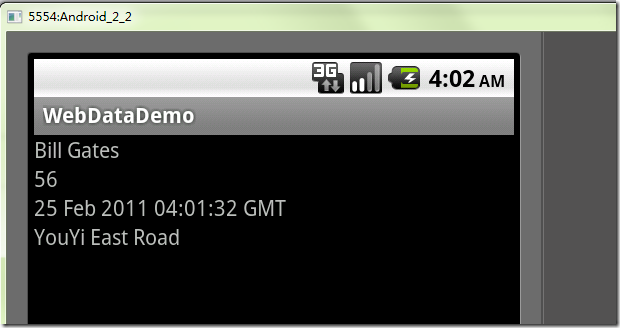Android用GSon处理Json数据
2014-06-18 09:23
369 查看
此篇接上篇 Android访问WCF(下篇)-客户端开发 将服务器获取的JSON数据通过GSON这个类库,
进行反序列化, 并通过UI显示出来.
如何在Android平台上用GSON反序列化JSON数据, 参考了这篇文章 http://benjii.me/2010/04/deserializing-json-in-android-using-gson/
一. 建立我们包装好的Http请求类文件 WebDataGetApi.java
二. 建立JsonDataGetApi.java
三. 建立Android端Account模型Account.java
四. 在我们的主Activity中调用刚才的方法,
在这一步中我们需要引入Google的gson 库gson-1.6.jar至我们的工程(下载地址)
五.我们开始构建UI
打开layout下的main.xml
在配置好RunConfiguration之后,我们开始运行程序, 查看Log发现有以下错误,

意思是说访问被禁止,也就是未授权访问, 其意思并不是我们的服务未授权, 因为Andriod具有很好的很好很好的安全机制, 我们要访问网络必须要经过授权才可以;
我们打开res目录下AndroidManifest.xml, 注意字体加粗放大的那句, 就是给我们的程序加入Internet的访问授权.
再次运行程序, 会发现显示如下:


从上图中的statuscode = 200来看,说明我们的请求已经成功, 问题出现在Json Parse(Json数据转换/反序列化/格式化)的过程中, 我们现在把从服务器传过来的数据拿出来看看, 在浏览器输入我们的服务地址: http://localhost:82/AccountService/Json/GetAccountData
我们发现其中的Birthday的结果并非我们想象中yyyy-mm-dd HH:mm:ss类型, 究其原因可以查看MSDN文章《JavaScript
和 .NET 中的 JavaScript Object Notation (JSON) 简介》
现在我们给我们的GsonBuilder指定Date的序列化方法, 先增加一个Date反序列化的类DateDeserializer.java
其次修改Activity类中的GetDate方法如下,
注意其中加粗的部分.
我们现在再运行程序 :

执行成功.
示例下载
转载:http://www.cnblogs.com/VinC/archive/2011/02/25/Use-GSon-Hand-JsonData-For-Android-Device.html
进行反序列化, 并通过UI显示出来.
如何在Android平台上用GSON反序列化JSON数据, 参考了这篇文章 http://benjii.me/2010/04/deserializing-json-in-android-using-gson/
一. 建立我们包装好的Http请求类文件 WebDataGetApi.java
package com.demo;
import java.io.IOException;
import java.io.InputStreamReader;
import java.io.UnsupportedEncodingException;
import org.apache.http.HttpEntity;
import org.apache.http.HttpResponse;
import org.apache.http.client.methods.HttpGet;
import org.apache.http.impl.client.DefaultHttpClient;
import org.apache.http.params.BasicHttpParams;
import org.apache.http.protocol.HTTP;
import android.util.Log;
public class WebDataGetApi {
private static final String TAG = "WebDataGetAPI";
private static final String USER_AGENT = "Mozilla/4.5";
protected String getRequest(String url) throws Exception {
return getRequest(url, new DefaultHttpClient(new BasicHttpParams()));
}
protected String getRequest(String url, DefaultHttpClient client)
throws Exception {
String result = null;
int statusCode = 0;
HttpGet getMethod = new HttpGet(url);
Log.d(TAG, "do the getRequest,url=" + url + "");
try {
getMethod.setHeader("User-Agent", USER_AGENT);
// HttpParams params = new HttpParams();
// 添加用户密码验证信息
// client.getCredentialsProvider().setCredentials(
// new AuthScope(null, -1),
// new UsernamePasswordCredentials(mUsername, mPassword));
HttpResponse httpResponse = client.execute(getMethod);
// statusCode == 200 正常
statusCode = httpResponse.getStatusLine().getStatusCode();
Log.d(TAG, "statuscode = " + statusCode);
// 处理返回的httpResponse信息
result = retrieveInputStream(httpResponse.getEntity());
} catch (Exception e) {
Log.e(TAG, e.getMessage());
throw new Exception(e);
} finally {
getMethod.abort();
}
return result;
}
/**
* 处理httpResponse信息,返回String
*
* @param httpEntity
* @return String
*/
protected String retrieveInputStream(HttpEntity httpEntity) {
int length = (int) httpEntity.getContentLength();
if (length < 0)
length = 10000;
StringBuffer stringBuffer = new StringBuffer(length);
try {
InputStreamReader inputStreamReader = new InputStreamReader(
httpEntity.getContent(), HTTP.UTF_8);
char buffer[] = new char[length];
int count;
while ((count = inputStreamReader.read(buffer, 0, length - 1)) > 0) {
stringBuffer.append(buffer, 0, count);
}
} catch (UnsupportedEncodingException e) {
Log.e(TAG, e.getMessage());
} catch (IllegalStateException e) {
Log.e(TAG, e.getMessage());
} catch (IOException e) {
Log.e(TAG, e.getMessage());
}
return stringBuffer.toString();
}
}二. 建立JsonDataGetApi.java
package com.demo;
import org.json.JSONArray;
import org.json.JSONException;
import org.json.JSONObject;
public class JsonDataGetApi extends WebDataGetApi {
private static final String BASE_URL = "http://10.0.2.2:82/AccountService/";
private static final String EXTENSION = "Json/";;
public JSONObject getObject(String sbj) throws JSONException, Exception {
return new JSONObject(getRequest(BASE_URL + EXTENSION + sbj));
}
public JSONArray getArray(String sbj) throws JSONException, Exception {
return new JSONArray(getRequest(BASE_URL + EXTENSION + sbj));
}
}三. 建立Android端Account模型Account.java
package com.demo;
import java.util.Date;
public class Account {
public String Name;
public int Age;
public String Address;
public Date Birthday;
}四. 在我们的主Activity中调用刚才的方法,
在这一步中我们需要引入Google的gson 库gson-1.6.jar至我们的工程(下载地址)
package com.demo;
import java.util.Date;
import org.json.JSONArray;
import org.json.JSONObject;
import com.google.gson.Gson;
import com.google.gson.GsonBuilder;
import android.app.Activity;
import android.os.Bundle;
import android.util.Log;
import android.widget.TextView;
import android.widget.Toast;
public class WebData extends Activity {
/** Called when the activity is first created. */
@Override
public void onCreate(Bundle savedInstanceState) {
super.onCreate(savedInstanceState);
setContentView(R.layout.main);
getJsonData();
}
public void getJsonData() {
JsonDataGetApi api = new JsonDataGetApi();
JSONArray jArr;
JSONObject jobj;
try {
//调用GetAccountData方法
jArr = api.getArray("GetAccountData");
//从返回的Account Array中取出第一个数据
jobj = jArr.getJSONObject(0);
GsonBuilder gsonb = new GsonBuilder();
//Json中的日期表达方式没有办法直接转换成我们的Date类型, 因此需要单独注册一个Date的反序列化类.
//DateDeserializer ds = new DateDeserializer();
//给GsonBuilder方法单独指定Date类型的反序列化方法
//gsonb.registerTypeAdapter(Date.class, ds);
Gson gson = gsonb.create();
Account account = gson.fromJson(jobj.toString(), Account.class);
Log.d("LOG_CAT", jobj.toString());
((TextView) findViewById(R.id.Name)).setText(account.Name);
((TextView) findViewById(R.id.Age)).setText(account.Age);
((TextView) findViewById(R.id.Birthday)).setText(account.Birthday
.toGMTString());
((TextView) findViewById(R.id.Address)).setText(account.Address);
} catch (Exception e) {
Toast.makeText(getApplicationContext(), e.getMessage(),
Toast.LENGTH_LONG).show();
e.printStackTrace();
TextView movie_Address = (TextView) findViewById(R.id.Address);
movie_Address.setText(e.getMessage());
}
}
}五.我们开始构建UI
打开layout下的main.xml
<?xml version="1.0" encoding="utf-8"?> <LinearLayout xmlns:android="http://schemas.android.com/apk/res/android" android:orientation="vertical" android:layout_width="fill_parent" android:layout_height="fill_parent"> <TextView android:id="@+id/Name" android:layout_width="fill_parent" android:layout_height="wrap_content" /> <TextView android:id="@+id/Age" android:layout_width="fill_parent" android:layout_height="wrap_content" /> <TextView android:id="@+id/Birthday" android:layout_width="fill_parent" android:layout_height="wrap_content" /> <TextView android:id="@+id/Address" android:layout_width="fill_parent" android:layout_height="wrap_content" /> </LinearLayout>
在配置好RunConfiguration之后,我们开始运行程序, 查看Log发现有以下错误,

意思是说访问被禁止,也就是未授权访问, 其意思并不是我们的服务未授权, 因为Andriod具有很好的很好很好的安全机制, 我们要访问网络必须要经过授权才可以;
我们打开res目录下AndroidManifest.xml, 注意字体加粗放大的那句, 就是给我们的程序加入Internet的访问授权.
<?xml version="1.0" encoding="utf-8"?> <manifest xmlns:android="http://schemas.android.com/apk/res/android" package="com.demo" android:versionCode="1" android:versionName="1.0"> <uses-permission android:name="android.permission.INTERNET"></uses-permission> <application android:icon="@drawable/icon" android:label="@string/app_name"> <activity android:name=".WebData" android:label="@string/app_name"> <intent-filter> <action android:name="android.intent.action.MAIN" /> <category android:name="android.intent.category.LAUNCHER" /> </intent-filter> </activity> </application> </manifest>
再次运行程序, 会发现显示如下:


从上图中的statuscode = 200来看,说明我们的请求已经成功, 问题出现在Json Parse(Json数据转换/反序列化/格式化)的过程中, 我们现在把从服务器传过来的数据拿出来看看, 在浏览器输入我们的服务地址: http://localhost:82/AccountService/Json/GetAccountData
[
{
"Address": "YouYi East Road",
"Age": 56,
"Birthday": "/Date(1298605481453+0800)/",
"Name": "Bill Gates"
},
{
"Address": "YouYi West Road",
"Age": 57,
"Birthday": "/Date(1298605481453+0800)/",
"Name": "Steve Paul Jobs"
},
{
"Address": "YouYi North Road",
"Age": 65,
"Birthday": "/Date(1298605481453+0800)/",
"Name": "John D. Rockefeller"
}
]我们发现其中的Birthday的结果并非我们想象中yyyy-mm-dd HH:mm:ss类型, 究其原因可以查看MSDN文章《JavaScript
和 .NET 中的 JavaScript Object Notation (JSON) 简介》
现在我们给我们的GsonBuilder指定Date的序列化方法, 先增加一个Date反序列化的类DateDeserializer.java
package com.demo;
import java.lang.reflect.Type;
import java.util.Date;
import java.util.regex.Matcher;
import java.util.regex.Pattern;
import com.google.gson.JsonDeserializationContext;
import com.google.gson.JsonDeserializer;
import com.google.gson.JsonElement;
import com.google.gson.JsonParseException;
public class DateDeserializer implements JsonDeserializer<Date> {
public Date deserialize(JsonElement json, Type typeOfT,
JsonDeserializationContext context) throws JsonParseException {
String JSONDateToMilliseconds = "\\/(Date\\((.*?)(\\+.*)?\\))\\/";
Pattern pattern = Pattern.compile(JSONDateToMilliseconds);
Matcher matcher = pattern.matcher(json.getAsJsonPrimitive()
.getAsString());
String result = matcher.replaceAll("$2");
return new Date(new Long(result));
}
}其次修改Activity类中的GetDate方法如下,
注意其中加粗的部分.
public void getJsonData() {
JsonDataGetApi api = new JsonDataGetApi();
JSONArray jArr;
JSONObject jobj;
try {
//调用GetAccountData方法
jArr = api.getArray("GetAccountData");
//从返回的Account Array中取出第一个数据
jobj = jArr.getJSONObject(0);
GsonBuilder gsonb = new GsonBuilder();
//Json中的日期表达方式没有办法直接转换成我们的Date类型, 因此需要单独注册一个Date的反序列化类.
DateDeserializer ds = new DateDeserializer();
//给GsonBuilder方法单独指定Date类型的反序列化方法
gsonb.registerTypeAdapter(Date.class, ds);
Gson gson = gsonb.create();
Account account = gson.fromJson(jobj.toString(), Account.class);
Log.d("LOG_CAT", jobj.toString());
((TextView) findViewById(R.id.Name)).setText(account.Name);
((TextView) findViewById(R.id.Age)).setText(String.valueOf(account.Age));
((TextView) findViewById(R.id.Birthday)).setText(account.Birthday
.toGMTString());
((TextView) findViewById(R.id.Address)).setText(account.Address);
} catch (Exception e) {
Toast.makeText(getApplicationContext(), e.getMessage(),
Toast.LENGTH_LONG).show();
e.printStackTrace();
}
}
}我们现在再运行程序 :

执行成功.
示例下载
转载:http://www.cnblogs.com/VinC/archive/2011/02/25/Use-GSon-Hand-JsonData-For-Android-Device.html
相关文章推荐
- Android 使用google-gson处理json格式数据
- Android只json数据的处理-Gson
- Android用GSon处理Json数据
- Android用GSon处理Json数据
- Android用GSon处理Json数据
- Android用GSon处理Json数据
- Android用GSon处理Json数据
- Android用GSon处理Json数据
- Android中使用Gson解析JSON数据
- Gson对Json数据的处理
- Axis2与Android的Json(Gson)通信传数据
- Android解析json数据(Gson)
- Android利用Gson实现对象和Json数据的相互转换
- Android[中级教程]第八章 Json数据的处理
- Android中使用Gson解析JSON数据的两种方法
- Android之Gson解析JSON数据
- Android下使用Gson解析JSON数据
- Android下使用Gson解析JSON数据
- Android进阶篇-Gson解析Json数据
- Android中使用Gson解析JSON数据
